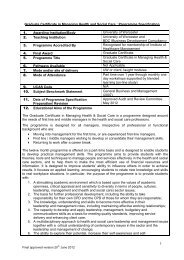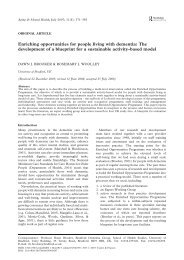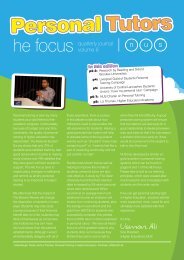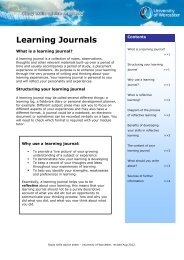INDG364: The right start: Work experience for young people: Health ...
INDG364: The right start: Work experience for young people: Health ...
INDG364: The right start: Work experience for young people: Health ...
- No tags were found...
You also want an ePaper? Increase the reach of your titles
YUMPU automatically turns print PDFs into web optimized ePapers that Google loves.
THE RIGHT START<strong>Work</strong> <strong>experience</strong> <strong>for</strong> <strong>young</strong> <strong>people</strong>:<strong>Health</strong> and safety basics <strong>for</strong> employersHSE<strong>Health</strong> & SafetyExecutive
<strong>The</strong> <strong>right</strong> <strong>start</strong><strong>Work</strong> <strong>experience</strong> introduces <strong>young</strong><strong>people</strong> to the world of work and is avaluable and essential part of theireducation. HSE sees it as an excellentopportunity to give them a goodgrounding in health and safety.Your contribution as a work <strong>experience</strong>provider is greatly appreciated. Thisleaflet will help you, and thoseresponsible <strong>for</strong> work <strong>experience</strong> in yourcompany, ensure that <strong>young</strong> <strong>people</strong> havetheir health and safety protected whilethey are with you.2
<strong>The</strong> <strong>right</strong> <strong>start</strong>INTRODUCTIONWhen you offer a work <strong>experience</strong> placement to students you havethe same responsibilities <strong>for</strong> their health, safety and welfare as <strong>for</strong> allyour work<strong>for</strong>ce. Under health and safety law, these students will beregarded as your employees.As an employer, you will already have to carry out a riskassessment. This means looking at what in your work could causeharm to <strong>people</strong>, so that you can weigh up whether you have takenenough precautions or should do more to prevent harm.This leaflet tells you what you need to do when assessing the healthand safety risks to all the <strong>young</strong> <strong>people</strong> in your work<strong>for</strong>ce below theage of 18, including work <strong>experience</strong> students. It will also give yousome idea of the sort of questions work <strong>experience</strong> organisers (andthis may include schools) are likely to ask you about your healthand safety arrangements.Definitions of <strong>young</strong> <strong>people</strong> and children by ageIt is helpful to know how <strong>people</strong> are defined by age in health andsafety law, especially when working out what the <strong>young</strong> person isallowed to do:■■a <strong>young</strong> person is anyone under 18 years old (referred to in thisbooklet as ‘<strong>young</strong> <strong>people</strong>’);a child is anyone who has not yet reached the official age atwhich they may leave school, just be<strong>for</strong>e or just after their 16thbirthday (this is often referred to as the minimum school leavingage (MSLA)).3
<strong>The</strong> <strong>right</strong> <strong>start</strong>ASSESSING THE RISKSUnder health and safety law, you must assess the risks to <strong>young</strong><strong>people</strong> under 18 years old, be<strong>for</strong>e they <strong>start</strong> work/work<strong>experience</strong> and tell them what the risks are.You should also:■■■■take into account that these <strong>young</strong> <strong>people</strong> are likely to bein<strong>experience</strong>d, unaware of health and safety risks and physicallyor mentally immature;put in place measures to control the risks which will removethem altogether or reduce them to the lowest possible level;let the parents/guardians of any students (and employees) belowminimum school leaving age know the key findings of the riskassessment and the control measures taken be<strong>for</strong>e the <strong>young</strong><strong>people</strong> <strong>start</strong> work/work <strong>experience</strong>; andkeep a record of the main findings of the risk assessment, if youhave five or more employees (including <strong>young</strong> <strong>people</strong> on work<strong>experience</strong>).You may be able to use or adapt a general risk assessment <strong>for</strong> <strong>young</strong><strong>people</strong> doing the same job or work <strong>experience</strong>. But in all cases youwill need to:■■■■cover all the necessary features listed on the opposite page;keep the risk assessment up to date;look again at the risks if you have reason to believe that theoriginal assessment no longer holds good; andbear in mind any in<strong>for</strong>mation about the <strong>young</strong> person’s needswhich may be passed on by the work <strong>experience</strong> organiser, theschool or the parents.You can find out more about risk assessment in the following HSEpublications:4
<strong>The</strong> <strong>right</strong> <strong>start</strong>■■Young <strong>people</strong> at work. A guide <strong>for</strong> employers - contains advice onwhat is required and how employers may be helped byorganisers in in<strong>for</strong>ming parents/guardians;Five steps to risk assessment - a brief guide to help small businessesprepare a risk assessment.SPECIAL FEATURES OF THE RISK ASSESSMENT<strong>The</strong> law requires you to take account of a number of points inyour risk assessment be<strong>for</strong>e a <strong>young</strong> person <strong>start</strong>s work orwork <strong>experience</strong>.Try to look at your workplace from an adolescent’s viewpoint. Whatdangers will they recognise? <strong>The</strong>y may not be fully grown - willthey find their workplace awkward and the tools too big?In particular you should look at:■■■■■■how the workplace is fitted and laid out (and the particular sitewhere they will work);what type of work equipment will be used and how it will behandled;how the work is organised;the need to assess and provide health and safety training;the nature of any physical, biological and chemical agents theymay be exposed to, <strong>for</strong> how long and to what extent; andthe risks from certain work hazards (you will find furtherin<strong>for</strong>mation on the nature of specific risks to <strong>young</strong> <strong>people</strong> inYoung <strong>people</strong> at work: A guide <strong>for</strong> employers. This includes any workthey cannot do because of their age).You must not allow the <strong>young</strong> person to do the work where youfind that a significant risk remains in spite of your best ef<strong>for</strong>ts totake all reasonable steps to control it.5
<strong>The</strong> <strong>right</strong> <strong>start</strong>OUTCOME OF THE RISK ASSESSMENTYour risk assessment may bring to light certain risks which<strong>young</strong> <strong>people</strong> cannot be exposed to under health and safety law.You must protect your <strong>young</strong> employees and work <strong>experience</strong>students from the risk of accidents or ill health which they areunlikely to recognise because:■■■they are in<strong>experience</strong>d; orhave not been trained; orthey may not pay enough attention to safety.Restrictions on work<strong>The</strong> overall rule is that <strong>young</strong> <strong>people</strong> under 18 years old must not beallowed to do work which:■■■■cannot be adapted to meet any physical or mental limitationsthey may have;exposes them to substances which are toxic or cause cancer;exposes them to radiation;involves extreme heat, noise or vibration.Young <strong>people</strong> who are over the MSLA can do this work under veryspecial circumstances, which are:■■■the work is necessary <strong>for</strong> their training;the work is properly supervised by a competent person; andthe risks are reduced to the lowest level, so far as is reasonablypracticable.Children below the MSLA must never do work involving theserisks whether they are employed or under training such as work<strong>experience</strong>.6
<strong>The</strong> <strong>right</strong> <strong>start</strong>TRAINING AND SUPERVISIONYoung <strong>people</strong> need training most when they <strong>start</strong> a job or work<strong>experience</strong>. <strong>The</strong>y need to be trained to do the work without puttingthemselves and other <strong>people</strong> at risk.It is important that you check they have understood training whichcovers, <strong>for</strong> example:■■■the hazards and risks in the workplace;the control measures put in place to protect their health andsafety;a basic introduction to health and safety, <strong>for</strong> example first-aid,fire and evacuation procedures.Young <strong>people</strong> will be facing unfamiliar risks from the job they willbe doing and from their surroundings and are there<strong>for</strong>e likely toneed more supervision than adults. Good supervision will also helpyou to get a clear idea of their progress in the job and to monitor theeffectiveness of their training. You can find out more aboutsupervision good practice in two helpful guides produced by theLearning and Skills Council (see the ‘References’ section <strong>for</strong> details).Employee or trade union health and safety representatives can playa valuable role early on, <strong>for</strong> example by:■■■introducing the <strong>young</strong> person to the workplace;helping with their ongoing training; andgiving you feedback about particular concerns, especially as the<strong>young</strong>ster may not feel confident to speak to their boss directly.7
<strong>The</strong> <strong>right</strong> <strong>start</strong>QUESTIONS YOU MIGHT BE ASKED WHEN OFFERING WORKEXPERIENCESchools or work <strong>experience</strong> organisers need to satisfy themselvesabout your management of health and safety. This is part of theirlegal responsibilities towards the <strong>young</strong> <strong>people</strong> they send to workplacements. You can expect them to ask you questions such as:■■■■■■■■Do you have a health and safety policy and how do you carry itout? (It must be written down if you have five or moreemployees, including work <strong>experience</strong> participants.)Have you carried out a risk assessment recently and does it coverthe particular risks from the work <strong>experience</strong>?Have you taken the necessary measures to control these risks?Is there a named person in the workplace who will beresponsible <strong>for</strong> work <strong>experience</strong> students?How will work <strong>experience</strong> students be supervised and givenhealth and safety induction and training?Can you draw up a clear plan of the work <strong>experience</strong>?Will you provide any necessary personal protective equipment?Can you make appropriate arrangements <strong>for</strong> <strong>young</strong> <strong>people</strong> withspecial needs, <strong>for</strong> example those who have particular disabilitiesor learning difficulties? (<strong>The</strong> work <strong>experience</strong> organiser shouldgive you full in<strong>for</strong>mation and any necessary advice well inadvance of the placement. You will need to alter the riskassessment to take account of this.)<strong>The</strong> work <strong>experience</strong> organiser may ask about other things whichshow that you pay proper attention to health and safety, <strong>for</strong> example:■■■Have you registered with the appropriate health and safetyen<strong>for</strong>cement authority? (You can ring HSE’s InfoLine <strong>for</strong> morein<strong>for</strong>mation on how to do this – see back cover <strong>for</strong> details.)What are your systems <strong>for</strong> dealing with any accidents andemergencies?Do you arrange training on fire procedures <strong>for</strong> staff and work<strong>experience</strong> students?8
<strong>The</strong> <strong>right</strong> <strong>start</strong>■■■■■■Do you provide first-aid equipment and keep records of first-aidtreatment?If required, are trained first aiders available?Is an accident book available and do you know about your legalduties to report accidents?Have you carried out an assessment of substances which mightcause ill health under the Control of Substances Hazardous to<strong>Health</strong> Regulations 1999?Do you have adequate insurance, including Employer'sLiability Insurance and Public Liability Insurance and MotorVehicle insurance where required, and does that cover extendto work <strong>experience</strong> students?Do you consult employees on health and safety and have youappointed employee health and safety representatives?WHEN THE WORK EXPERIENCE ORGANISER VISITS YOURWORKPLACEWhen visiting the site of a work <strong>experience</strong> placement, the work<strong>experience</strong> organiser will be looking <strong>for</strong> pointers which show thatyou pay proper attention to the health, safety and welfare of youremployees. You should already have taken into account thesefactors in your risk assessment, <strong>for</strong> example:■■■■■■■■housekeeping;lighting;seating;guarding of machines;fire precautions;electrical wiring;toilets and washing facilities;provision of personal protective equipment.This is not a complete list and there are other important things toconsider such as how noisy the workplace is.9
<strong>The</strong> <strong>right</strong> <strong>start</strong><strong>The</strong> work <strong>experience</strong> organiser may ask you to sign a writtenagreement which can be especially helpful in making theresponsibilities of both sides clear. Sometimes this is combined withconsent from the parent/guardian and the <strong>young</strong> person. Forinstance, the parent/guardian will be able to see your riskassessment and control measures and at the same time you will beable to see in<strong>for</strong>mation on, <strong>for</strong> example, the health of the student.<strong>The</strong> agreement could also set out:■■■a plan of work <strong>for</strong> the placement;arrangements <strong>for</strong> instruction and training be<strong>for</strong>e the work<strong>start</strong>s; andhow the <strong>young</strong> person will be supervised and who will beresponsible.10
<strong>The</strong> <strong>right</strong> <strong>start</strong>REFERENCES<strong>The</strong> following <strong>Health</strong> and Safety Executive publications areavailable from HSE Books (see back cover <strong>for</strong> details):Managing health and safety on work <strong>experience</strong>: A guide <strong>for</strong> organisersHSG199 HSE Books 2000 ISBN 0 7176 1742 4Young <strong>people</strong> at work: A guide <strong>for</strong> employers HSG165 (Second edition)HSE Books 2000 ISBN 0 7176 1889 7Management of health and safety at work. Management of <strong>Health</strong> andSafety at <strong>Work</strong> Regulations 1999. Approved Code of Practice and guidanceL21 (Second edition) HSE Books 2000 ISBN 0 7176 2488 9Five steps to risk assessment Leaflet INDG163(rev1) HSE Books 1998(single copy free or priced packs of 10 ISBN 0 7176 1565 0)<strong>The</strong> following DfES and Learning and Skills Council publicationsare available free from Prolog, PO Box 5050, Annesley, NottinghamNG15 0DJ (Tel: 0845 602 2260 Fax: 0845 603 3360):Improving work <strong>experience</strong> - A good practice guide <strong>for</strong> employers DfESguide EG1GRaising standards. Supervising learners’ health and safety Learning andSkills Council GPS/RS/7Raising standards. <strong>Health</strong> and safety supervision of learners in theworkplace Learning and Skills Council GPS/RS/611
<strong>The</strong> <strong>right</strong> <strong>start</strong>FURTHER INFORMATIONHSE priced and free publications are available by mail order fromHSE Books, PO Box 1999, Sudbury, Suffolk CO10 2WA Tel: 01787881165 Fax: 01787 313995 Website: www.hsebooks.co.uk (HSEpriced publications are also available from bookshops.)For in<strong>for</strong>mation about health and safety ring HSE's InfoLineTel: 08701 545500 Fax: 02920 859260 e-mail:hsein<strong>for</strong>mationservices@natbrit.com or write to HSE In<strong>for</strong>mationServices, Caerphilly Business Park, Caerphilly CF83 3GG. You canalso visit HSE’s website: www.hse.gov.ukThis leaflet contains notes on good practice which are notcompulsory but which you may find helpful in consideringwhat you need to do.This leaflet is available in priced packs of 15 from HSE Books, ISBN0 7176 2547 8. Single free copies are also available from HSE Books.This publication may be freely reproduced, except <strong>for</strong> advertising,endorsement or commercial purposes. First published 09/02. Pleaseacknowledge the source as HSE.<strong>INDG364</strong>Printed and published by the <strong>Health</strong> and Safety ExecutiveC1500 09/0212
















